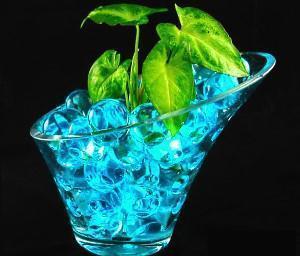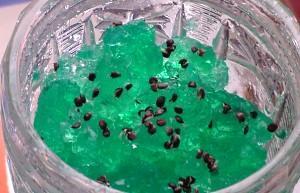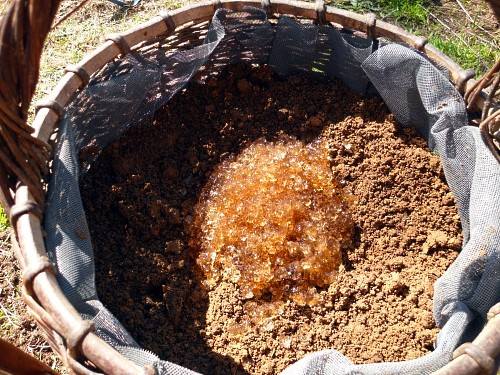Seedling hydrogel - the new assistant of the vegetable grower
 Seedling hydrogel is a polymer material that allows you to get great seedlings. In the process of development, the plant is fully provided with all nutrients.
Seedling hydrogel is a polymer material that allows you to get great seedlings. In the process of development, the plant is fully provided with all nutrients.
Growing seedlings is often difficult. Getting strong seedlings requires not only well-prepared soil and a well-lit place, but also proper watering. It is moisture that can be both a friend for young seedlings and cause decay of the root system, leading to further death.
The use of a new polymer material with a unique ability to absorb and retain the required amount of water in the soil for plant growth will help to avoid such situations.
The hydrogel can be used as a planting soil (a kind of reservoir with water) or as a moisture-retaining additive in a prepared substrate.

Polymer granules absorb moisture and liquid fertilizers, which allows you to supply plants with the necessary nutrition as they are needed. Hydrogel for seedlings is considered an ideal material, which makes it possible to minimize the care of young seedlings at times and reduce stress when transplanting into open ground.
Initially, the material looks like small balls resembling beads. After adding liquid to dry crystals, it swells, after which the granules are ready for use.
Pros and cons of hydrogel
However, the new material among vegetable growers has not yet acquired mass distribution. This is primarily due to its recent appearance on our market and ignorance of its main advantages. So that the grower does not wonder whether it is worth using a hydrogel for growing seedlings, we will consider all its advantages and disadvantages.
The use of polymer granules for a gardener gives the following positive points:
- The amount of water absorbed by the hydrogel is 300 times its own weight, which allows maintaining the necessary soil moisture for a long time.
- Possibility to save space.
- Seed growth begins much earlier than with traditional cultivation.
- The seeds and root system of the seedlings are aerated.
- All microelements present in the substrate prepared for planting are not washed out and completely preserved.
- Throughout the entire growing cycle, the plant is in favorable conditions.
- Cost effective material. For one liter of the base, 0.8 ... 1.6 g of dry material will be enough.
With the obvious advantages available, the disadvantages of using a hydrogel are:
- The inability to grow crops with leathery seed shells (sweet peas, etc.) Also, when introducing seeds into a hydrogel, the individual characteristics of the plant should be taken into account.
- Maintain the required temperature of the surface on which the seedlings with hydrogel are located. This will help to avoid hypothermia of seedlings.
- Granules cannot be reused, although advertisers claim otherwise. Reviews of the hydrogel in which the seedlings have already grown are not too positive.First of all, its main absorbing qualities are lost, moreover, it shrinks and darkens. When the jelly-like granules interact with air, bacteria can settle in it. The maximum that such material can be suitable for is using it as a water-retaining additive in the soil.
All the above pros and cons of the hydrogel will allow the grower to realistically assess his chances of getting good seedlings.
Methods for using the hydrogel
Polymer granules can be used in several ways:
- First way. The seeds are poured into the prepared jelly-like mass. To do this, you will need to pre-soak the hydrogel granules. After swelling, they should be rubbed through a sieve or crushed with a blender until a homogeneous mass is formed.
Further, a 3 cm layer of hydrogel is lined in the planting containers and seeds are laid out on it, slightly pressing it. Also, the resulting jelly-like mass can be cut into large pieces, and then laid out the seed.
It is not worth deeply deepening the seeds, since they can lose oxygen access, which will affect the number of seedlings. To create a microclimate, the planting containers are covered with plastic wrap. The cover can be removed once a day to ventilate and remove condensation. - Second way. The use of a hydrogel as a moisture-retaining additive in the substrate has a good effect. In this case, three to four parts of the planting soil are mixed with one part of dry granules, after which the resulting mixture is poured into prepared containers.
- Third way. Also, the seedling hydrogel can be used in a combined way when planting plants in open ground. The root system is dipped into the swollen mass, and young seedlings are planted in the holes. This method will allow the plant to reduce stress and provide moisture for the first time.

Hydrogel is an environmentally friendly material that not only stimulates plant growth, but also has a positive effect on soil quality.
Read also: using peat tablets for seedlings!